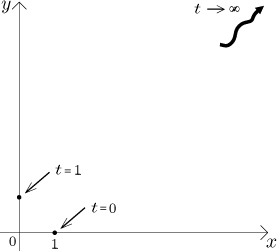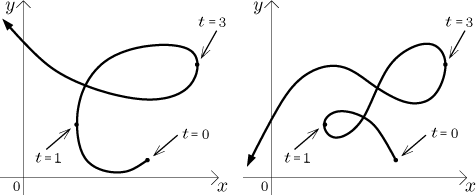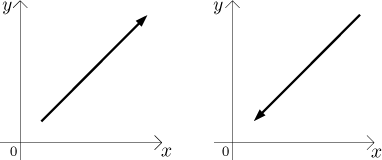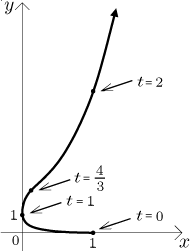
Consider a parametric curve given by equations
x = x(t),
y = y(t) for t in some interval
I.
Assume that the functions
First we will try to see as much as possible with the description we have and then we will use the function approach. Most of it is common sense; the most important thing to keep in mind is that we will be mixing a "time" point of view and a spatial point of view, moving information from one framework to another. Knowing where you stand at any given phase of calculations is crucial and also pretty much sufficient for success. In order to illustrate out reasoning we will simultaneously work on an example.
Example: Investigate the parametric curve
x = (t − 1)2,
y = t3,
t ≥ 0.
Theory:
What can we say from the description itself? The first important information
is about the ends. If the interval I includes some of its endpoints,
then substituting this time into x and y we learn where the path
starts or ends. If some endpoint is not included, then we find the
appropriate one-sided limit of x and y with respect to t.
Interpreting this information can be interesting. If both limits are proper,
then the curve simply goes toward the point we obtained. If both limits are
improper, then the curve goes to one of the corners. Common sense should
guide us, for instance if

An interesting case is when one limit is proper and one improper. We then obtain a horizontal or a vertical asymptote as suggested in this picture:

Another traditional piece of data is intercepts. The
Back to our Example: The interval
![]()
Thus the curve starts at the point
Intercepts: The

Theory: Now we look for other points from the curve. Of course, we want "important" points, points where something changes. We start with x. This variable records movement in horizontal direction, so when x grows, the path moves left to right. If x decreases, the path moves right to left. Local extrema of x as a function are turning points for the path. Thus the next natural step is to investigate x itself as a function for monotonicity, but instead of increase/decrease we will interpret the signs of its derivative as right/left movement of the path. The times t that give local extrema of x will, when substituted into x and y, give turnaround points.
Note that this information is not enough to get a good sense of the path. In the following picture, both curves have identical turnaround points with respect to x and identical left/right directions, but they are rather different.

To get better information we similarly investigate the function y that gives vertical movement, so when we investigate it as an independent function, then the times t giving local extrema will show points where the path changes between going up and down.
Back to our Example: We find
![]() (t) = 2(t − 1),
(t) = 2(t − 1),

The turnaround time
We also have
![]() (t) = 3t2,
(t) = 3t2,

We get a better idea of the direction of the path when we combine the separate tendencies together.

Now we know the basic directions and we can sketch a rough picture.

Note an interesting thing. When we look at pieces of this curve as on graphs
given by some

In the chart above this corresponds to disregarding the arrows, then we just
get increasing or decreasing tendencies of a graph. Note that the picture
above shows that we get an increasing graph for combinations + + and
− − of signs of
![]()
![]() .
.![]() /
/![]()
So far we did not really need the function point of view. As we just saw, we can investigate the left-right and up-down movement, or we can consider a function y describing the graph and investigate its sign, in the end we get the same tendencies of the curve. However, now we would like to refine the picture, which calls for concavity and there we do need the function approach.
We recall the formula for the second spatial derivative:
![]()
Back to our Example: In our case we get
![]()
What are the dividing times for concavity? From the numerator we have

The time
![]()
Now we should be able to sketch the curve. Since we have little information
about times beyond

One more trick to try: When the time is really big, then x is
approximately t2. We can express t from this,
substitute into y and we learn that for really large times the curve
looks like the graph of